Troy-Bilt 18 In. 208cc Dual Rotating Rear Tine Tiller Review
- February 26, 2024
- 0 comment
Transform your gardening experience with the Mustang™ DD 208cc 18″ Rear Tine Tiller, your ultimate partner for both new projects and garden upkeep. Powered by a robust 208cc OHV engine, it tackles the toughest terrains with ease. Its self-propelled drive, featuring both forward and reverse gears, ensures effortless maneuverability. The innovative dual-direction tines adapt to your soil’s needs, making it simple to penetrate hard ground and refine soil texture. Ideal for seasoned gardeners and novices alike, this tiller redefines efficiency and precision in garden management.
Specifications
- Engine: 208cc OHV Troy-Bilt engine
- Tilling width: 18 inches
- Tilling depth: 7.5 inches
- Tine diameter: 13 inches
- Tine rotation direction: Dual-direction (forward and counter-rotating)
- Wheels: 16 x 4 inch pneumatic
- Weight: 240 pounds
Key Features
Powerful 208cc Engine
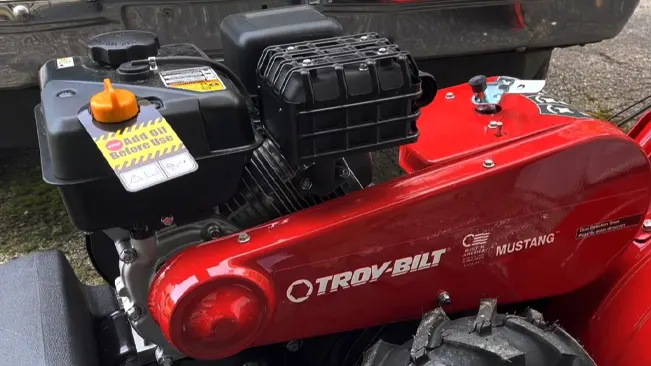
At the core of the Mustang tiller lies its powerful 208cc engine. This isn’t just any ordinary engine; it’s an overhead valve (OHV) engine, which is a testament to its efficiency and power. OHV engines are known for their compact design and ability to deliver more power by utilizing a more efficient airflow through the engine, translating to more torque. This torque is crucial when the tiller faces tough, compacted soil, as it provides the force needed to break through and turn over the soil effectively. For gardeners dealing with challenging terrain or hardy soil types, this power can make the difference between a successful tilling session and a strenuous struggle with the land.
Large Gas Tank with Chained Lid
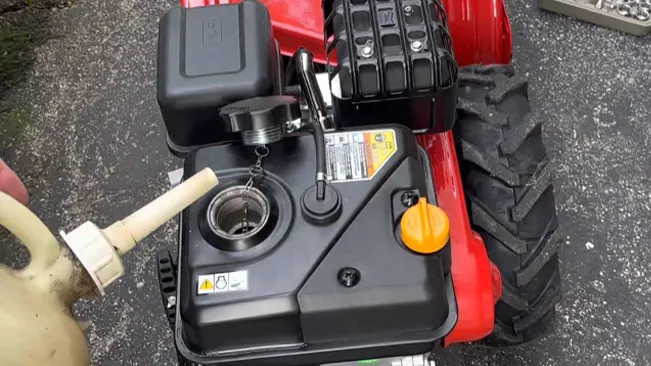
One of the more practical features of the Mustang tiller is its large gas tank, which comes with a unique chained lid. This might seem like a small detail, but it significantly enhances the user experience. The large tank means you can fill up less frequently, allowing for longer uninterrupted tilling sessions. This is particularly beneficial for those with larger plots of land or professional landscapers who need to maximize their efficiency on the job. The chained lid is a thoughtful addition that addresses a common annoyance with outdoor power equipment: lost gas caps. By securing the lid with a chain, you’re less likely to misplace it during refills or maintenance, a simple yet effective solution to a common problem.
Easy Start Mechanism
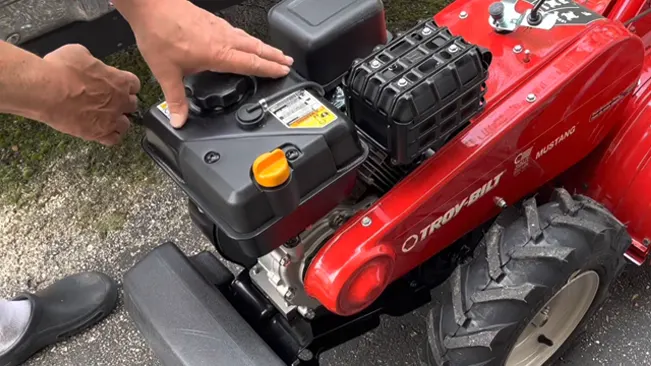
Starting power equipment can often be a challenge, especially for those who might not have the strength or technique to manage a stubborn pull-start mechanism. The Mustang tiller shines in this aspect with its easy start mechanism. Designed to fire up with a simple, smooth pull, this feature minimizes the effort required to begin tilling. This ease of start not only makes the tiller more accessible to a wider range of users but also reduces the dread associated with the often frustrating process of starting gas-powered equipment. It’s a relief to know that you can get right to work with minimal fuss, making the gardening experience more enjoyable and less of a chore.
Practical Experience
Setting Up for Tilling
Before diving into the heart of gardening or landscaping work with the Mustang™ DD 208cc 18″ Rear Tine Tiller, there’s an essential preparatory step that must be undertaken: setting the tiller for the appropriate tilling depth. This initial setup is pivotal for ensuring the tiller operates optimally, tailored to the specific needs of the soil and the task at hand. Adjusting the tiller to the desired depth is somewhat intricate, involving the removal and reinsertion of pins that set the tilling blades at the correct depth. While this might sound straightforward, it can be a bit cumbersome, especially for those new to tilling or when working under less than ideal conditions, such as uneven terrain or tight spaces.
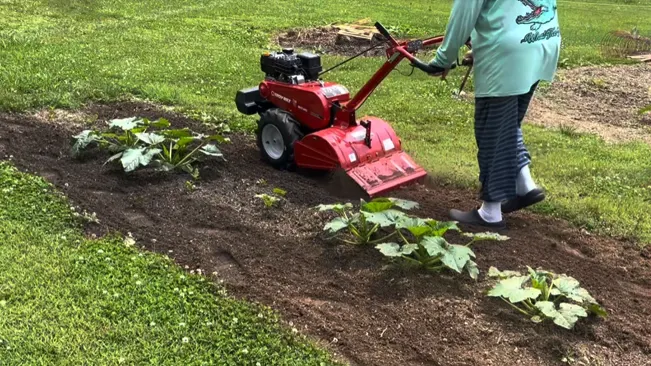
The process, however, becomes considerably more manageable with an extra pair of hands. Assistance during this setup phase can significantly ease the burden, making it a less daunting task. An assistant can help stabilize the tiller, hold components in place, or assist in aligning the pins correctly, which can be particularly helpful if adjustments need to be made on the fly. This collaborative effort in setting up the tiller not only makes the task more efficient but also ensures that the tiller is precisely calibrated for the work ahead, laying the groundwork for a successful tilling session.
Performance in Action
Once the setup is meticulously completed, the Mustang tiller is ready to spring into action, and it does so with commendable efficacy. The moment it penetrates the soil, the tiller’s performance becomes apparent, as it robustly churns through the earth, breaking it up and turning it over to the preset depth. This capability to effectively aerate and prepare the soil makes it an invaluable tool for gardeners and landscapers alike, facilitating the growth of healthy plants and the creation of stunning outdoor spaces. The tiller’s robust engine and durable tines are designed to handle various soil types, from soft, loamy earth to tougher, more compacted grounds, making it a versatile tool for a wide range of tilling tasks.
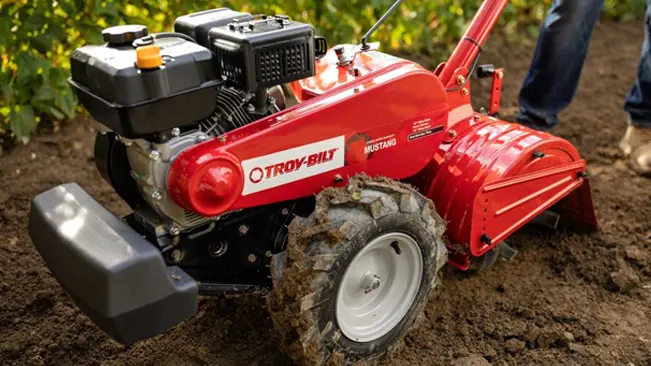
However, the experience of operating the Mustang tiller isn’t without its nuances. One aspect that stands out for potential improvement is the gear shifting mechanism. While the tiller excels in soil cultivation, transitioning between gears can sometimes feel less than seamless. Users have noted that engaging the desired gear can require a bit more effort or adjustment than one might expect, which could momentarily interrupt the smooth flow of tilling. This minor hiccup in what is otherwise a smooth operation suggests that a refinement in the gear shifting mechanism could further enhance the tiller’s user-friendliness. Such an improvement would not only make the tiller more accessible to a broader range of users but also contribute to a more enjoyable and efficient tilling experience, reinforcing the Mustang tiller’s position as a top choice among garden tools.
Table Comparison: Mustang™ DD 208cc vs. MTD Gold 18″ 208cc
| Feature | Mustang™ DD 208cc | MTD Gold 18″ 208cc |
|---|---|---|
| Engine Power | 208cc | 208cc |
| Tilling Width | 18 inches | 18 inches |
| Tilling Depth | Up to 7 inches | Adjustable, depth not specified |
| Fuel Tank Capacity & Design | Large with chained lid | Standard, no specific features mentioned |
| Starting Mechanism | Pull-start | Pull-start |
| Grip Design | Rubberized, non-fixed | Ergonomic, fixed |
| Depth Adjustment | Manual, requires assistance | Easy-adjust lever |
| Rotation Type | Standard rotating tines | Dual rotating tines for versatility |
| Durability & Build Quality | Good, some plastic components | Robust, with heavy-duty construction |
| Price Range | Mid-range | Similar, mid-range |
Deciding between the Mustang™ DD 208cc 18″ Rear Tine Tiller and the MTD Gold 18″ 208cc Dual Rotating Rear Tine Tiller boils down to your specific needs and priorities. Both offer a powerful 208cc engine and suitable 18″ tilling width for mid-sized to large gardens.
The Mustang™ boasts a convenient chained fuel tank lid and lower price tag, while the MTD Gold stands out with its dual rotating tines for better versatility in various soil conditions and an easy-adjust lever for depth control. Durability-wise, both are sturdy, but the MTD Gold claims a heavy-duty construction for potentially longer life.
If you prioritize ease of use and a secure fuel tank design, the Mustang™ might be your match. But if versatility, effortless depth adjustment, and potentially longer lifespan are more important, the MTD Gold could be the better choice. Ultimately, the right decision depends on your specific preferences and tilling tasks.
Pros and Cons of Mustang™ DD 208cc 18″ Rear Tine Tiller
Pros
- Powerful Engine: The 208cc engine provides robust power, making it capable of handling tough soil conditions and large tilling areas efficiently.
- Large Fuel Tank with Convenient Design: The large gas tank, equipped with a chained lid, ensures long operation times without frequent refills and reduces the risk of losing the cap.
- Ease of Starting: The tiller features an easy start mechanism, making it straightforward to get the engine running with minimal effort.
- Adjustable Tilling Depth: Allows users to set the tilling depth according to their specific gardening needs, offering versatility in soil preparation.
- Solid Construction: The tiller is built to last, with a durable design that can withstand regular use in various soil conditions.
Cons
- Grip Design: The rubberized grips are not fixed, which can lead to them sliding up and down during use, potentially affecting control and comfort.
- Depth Adjustment Process: Adjusting the tilling depth can be cumbersome and usually requires an assistant, which might not be convenient for all users.
- Shift Lever Material: The shifter is made from a lower quality metal, which may affect durability and the overall feel when engaging gears.
- Plastic Components: Some users might find the use of plastic parts, like the wing nuts for depth adjustment, to be less durable than metal alternatives.
- Gear Shifting: The process of shifting gears can be finicky, requiring precision to engage the desired setting, which might interrupt the workflow and efficiency during use.
Maintenance tips of Mustang™ DD 208cc 18″ Rear Tine Tiller
Regular Inspection and Cleaning
- After Use: Clean the tines and the body of the tiller to remove soil and debris, which can lead to rust or clogging.
- Tines: Check for any bent or damaged tines and replace them if necessary to maintain effective tilling.
Engine Care
- Oil Check: Regularly check the engine oil level and top it up if it’s low. Change the oil according to the manufacturer’s recommendations, usually after the first 5 hours of use and every 50 hours thereafter.
- Air Filter: Clean the air filter after every use and replace it periodically to ensure the engine runs smoothly. A clogged air filter can reduce the engine’s efficiency and lifespan.
- Spark Plug: Inspect the spark plug for signs of wear or corrosion and replace it annually to ensure reliable starts and optimal engine performance.
Fuel System Maintenance
- Fuel Quality: Use fresh, clean gasoline and avoid leaving fuel in the tank for extended periods of inactivity to prevent gum and varnish buildup.
- Fuel Tank: Check the fuel tank and the chained lid for any damage or leaks regularly. Ensure the lid is securely attached after refilling to prevent spillage.
Gearbox and Transmission
- Lubrication: Ensure that the gearbox and all moving parts are adequately lubricated. Refer to the manufacturer’s guide for specific lubrication points and recommended grease or oil types.
- Gear Shift: If the gear shifting becomes stiff or problematic, check for debris or damage in the mechanism and lubricate as needed.
Conclusion
In summary, the Mustang™ DD 208cc 18″ Rear Tine Tiller is a powerful and practical choice for both gardeners and landscapers. It’s equipped with a robust engine and features like a large gas tank and an easy-start mechanism, enhancing its efficiency and ease of use. While there are some drawbacks such as gear shifting difficulties and the need for assistance with depth adjustment, the tiller’s overall performance remains commendable. Adherence to maintenance guidelines is crucial for its longevity and optimal performance. Despite its few challenges, the Mustang Tiller is a valuable tool for anyone looking to ease their gardening tasks, offering reliability and effectiveness in soil preparation and cultivation.
FAQs
1. What type of fuel does the Mustang™ DD 208cc Tiller use?
The Mustang™ Tiller runs on regular unleaded gasoline, eliminating the need for oil-gas mixture preparations.
2. Can the tilling depth be adjusted on the Mustang™ Tiller?
Yes, the tilling depth can be adjusted up to 7 inches, allowing for versatile soil preparation suitable for various planting needs.
3. How do I start the Mustang™ Tiller?
The tiller features an easy pull-start mechanism. Ensure the machine is on a flat surface, set the choke if the engine is cold, and pull the starter cord to start the engine.
4. Are the grips on the Mustang™ Tiller fixed?
No, the grips on the Mustang™ Tiller are rubberized but not fixed, which means they might move during operation. It’s recommended to check and adjust them as necessary before use.
5. What should I do if I experience difficulty shifting gears?
If gear shifting is challenging, first ensure the tiller is on a level surface and not under load. If the issue persists, check for debris or obstructions in the gear mechanism and lubricate as needed. Consult the manual for detailed troubleshooting or consider seeking professional maintenance.
6. How often should I perform maintenance on the Mustang™ Tiller?
Regular maintenance, such as checking the oil level, cleaning the air filter, and inspecting the tines, should be done after every use. More comprehensive maintenance, like changing the oil and spark plug, should follow the manufacturer’s recommendations, usually based on usage hours.
7. Can the Mustang™ Tiller be used on all soil types?
The Mustang™ Tiller is designed to be versatile and powerful enough to handle a variety of soil types, from loamy to more compacted soils. However, extremely rocky or hard-packed clay soils may present more of a challenge.
8. What should I do if the rubberized grips start to slide during use?
If the grips slide during operation, stop the tiller and adjust them back into place. For a more permanent solution, consider securing them with grip tape or consulting a professional for advice.
9. Is the fuel tank cap secure during operation?
Yes, the fuel tank cap is attached with a chain to prevent it from getting lost and to ensure it remains secure during operation.
10. Where can I find replacement parts or get service for my Mustang™ Tiller?
Replacement parts and service can typically be obtained through the manufacturer or authorized service centers. Always use genuine parts to ensure compatibility and maintain the warranty.

Joel Cunningham
Forestry AuthorI'm Joel Cunningham, an expert in pruning and weed management with over a decade of experience. My skills are rooted in formal training and extensive practice, focusing on advanced pruning techniques and efficient weed control. I'm known for my quality work, precision, and deep understanding of plant health and soil dynamics. My contributions extend to educational initiatives where I share sustainable practices and advice, establishing myself as a reliable and authoritative figure in the gardening community.

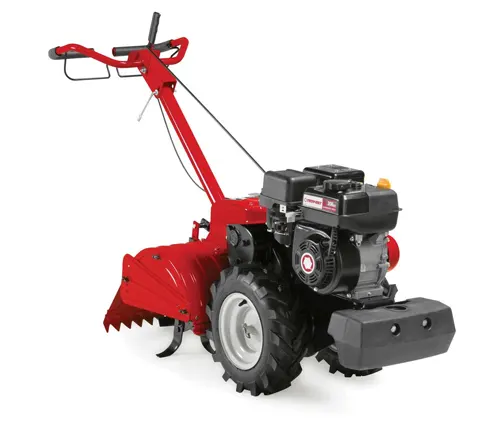
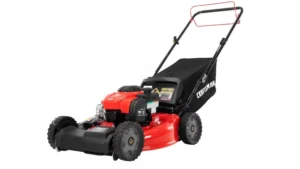


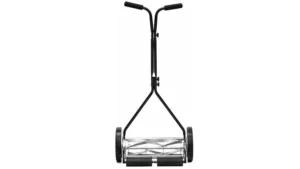



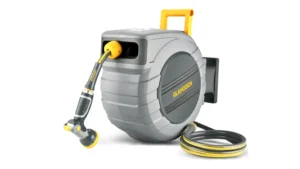

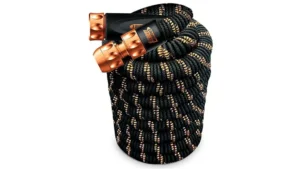


Leave your comment